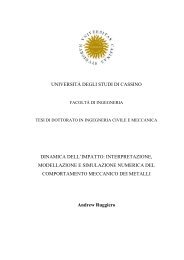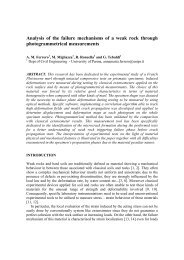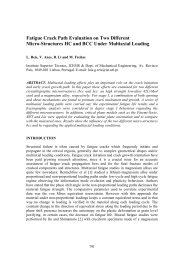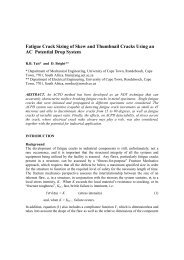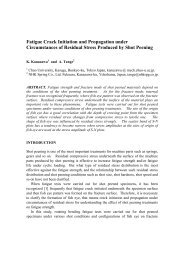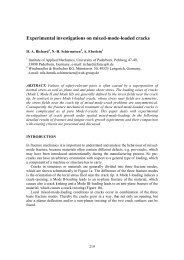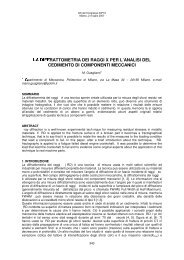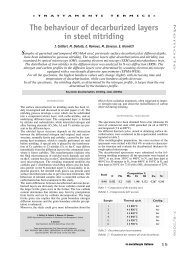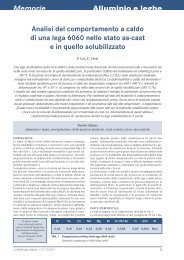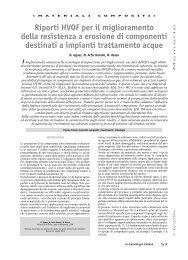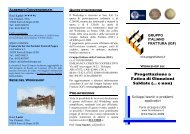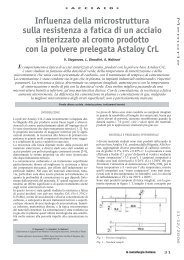Aspetti metallurgici e caratteristiche meccaniche in getti realizzati ...
Aspetti metallurgici e caratteristiche meccaniche in getti realizzati ...
Aspetti metallurgici e caratteristiche meccaniche in getti realizzati ...
You also want an ePaper? Increase the reach of your titles
YUMPU automatically turns print PDFs into web optimized ePapers that Google loves.
ACCIAIO INOSSIDABILE<br />
4/2004 Memorie<br />
sition and anneal<strong>in</strong>g temperature. Traditional b<strong>in</strong>ary phase<br />
diagrams off course cannot be useful to describe the ternary<br />
system Fe-Cr-Ni: therefore pseudob<strong>in</strong>ary diagrams or ternary<br />
sections are preferred. More recently phase equilibria<br />
of such multicomponent alloys can be calculated by computer<br />
programs. These calculated diagrams offer sufficient <strong>in</strong>dications<br />
on the microstructure modifications dur<strong>in</strong>g solidification<br />
and heat treatments of these alloys, for <strong>in</strong>stance:<br />
- ferrite is the first phase to solidify and only at the end of<br />
solidification also the austenite appears;<br />
- the duplex microstructure ferrite/austenite is stable only <strong>in</strong><br />
a limited temperature range;<br />
- at lower temperature the sigma phase appears, gradually<br />
replac<strong>in</strong>g the ferrite.<br />
Secondary phases<br />
In the temperature range 300-1000°C a number of undesirable<br />
secondary phases my form <strong>in</strong> the DSS. The more important<br />
and well known are: the σ-phase, χ-phase, secondary<br />
austenite γ2, the carbides M23C6 and M7C3, R-phase,<br />
π-phase, the α’from the sp<strong>in</strong>odal decomposition of the ferrite.<br />
The carbides formation <strong>in</strong> the DSS is not of great significance<br />
as <strong>in</strong> the austenitic steels, be<strong>in</strong>g limited by the precipitation<br />
of other <strong>in</strong>termetallic phases an by the high nitrogen<br />
content.<br />
Much more important are the TCP phases, and ma<strong>in</strong>ly the<br />
sigma phase, which is a stable constituent of the alloys at<br />
lowest temperatures. The sigma occur from the ferrite decomposition<br />
to sigma and austenite, but often the transformation<br />
is more complicated <strong>in</strong>volv<strong>in</strong>g other phases, like chi<br />
and carbides. Chromium and molybdenum <strong>in</strong>crease both the<br />
stability range and the precipitation rate of the sigma. To<br />
avoid this dangerous phase the high temperature anneal<strong>in</strong>g<br />
is essential, followed by a rapid quench<strong>in</strong>g.<br />
The χ-phase is an <strong>in</strong>termetallic, with a high molybdenum<br />
content. It is more stable at higher temperatures than the σ,<br />
with shorter precipitation times. Therefore often the χ is<br />
confused with the σ and appears as a metastable phase act<strong>in</strong>g<br />
as a precursor of the σ, hav<strong>in</strong>g similar dangerous effects<br />
on the properties.<br />
Also important <strong>in</strong> the DSS is the ferrite sp<strong>in</strong>doal decomposition,<br />
typical of the ferritic grades, known as the “475°C-embrittlement”.<br />
This phenomenon occur for times greater than<br />
1000 h at about 300°C.<br />
The ma<strong>in</strong> dangerous effect of secondary phases is the abrupt<br />
decrease of toughness. This <strong>in</strong>duce some important limitations<br />
on possible condition for the applications of the DSS:<br />
- the sp<strong>in</strong>odal decomposition determ<strong>in</strong>e the maximum temperature<br />
for long time exposures;<br />
- the χ and σ formation reduce the toughness both at room<br />
and high temperature, and therefore determ<strong>in</strong>e the lowest<br />
temperature of plastic deformation operations;<br />
- for room temperature applications the σ and χ have to be<br />
reduced to extremely low contents;<br />
- the σ reduce also the corrosion resistance, by the chromium<br />
depletion at the sigma-ferrite boundaries.<br />
Undoubtedly the dangerous secondary phases pose significant<br />
limitations on the DSS possible applications. However<br />
its formations and effects are well known and can be accurately<br />
controlled, allow<strong>in</strong>g the satisfactory application of<br />
the DSS.<br />
42<br />
la metallurgia italiana



